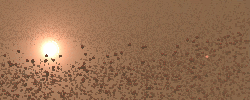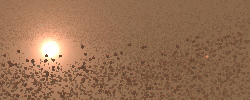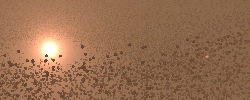
What
is radiative transfer?
When a ray of light passes through a medium, a fraction of its light can be removed from the ray, as well as some other light can be added to the ray. This is called radiative transfer. Basic physical processes responsible for this tempering of a ray of light are scattering, absorption and emission of light by the medium.
In the case of LELUYA, the medium is a dusty cloud around a star. The source of energy in the form of light is the star. When we look toward the star, its light is tampered as mentioned above. In addition, the whole cloud emits light because some stellar light is scattered toward us by the dust particles. Also, these particles emit light (mostly in the form of infrared light) because they are heated by the star (through the light absorption process) and thus have a certain temperature.
LELUYA's job is to find out how exactly all these processes are balanced in such a cloud. This is a very difficult problem to solve because each single speck of the dust cloud behaves as an energy source for the whole cloud.
Removing
energy from a light beam
A beam of light emitted by the star or a dust particle is traveling
through the cloud and trying to escape from it. There is a probability
that at any moment a fraction of the beam's energy is intercepted by the
cloud's dust particles and:
| ...
absorbed |
...
scattered away |
Adding
energy into a light beam
A beam of light emitted by the star or a dust particle is traveling toward
us through the cloud. Along the path, the cloud's dust particles provide
additional energy for the beam by:
| ...
emission |
...
scattering of other light beams |
beginner
level
---- What is radiative
transfer?
advanced level
---- Introduction to the
radiative transfer
equations?
expert level
---- Introduction to the
computational
algorithm: overview


